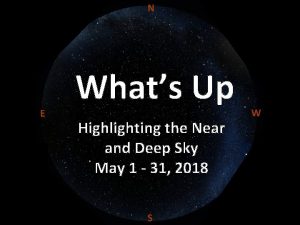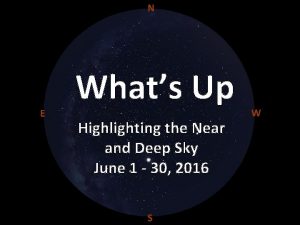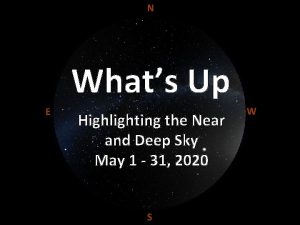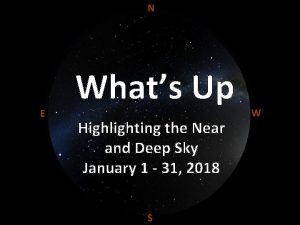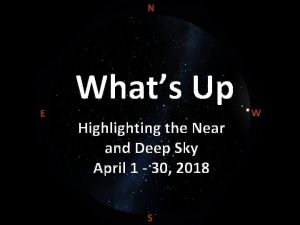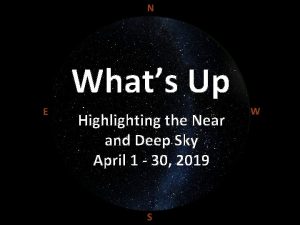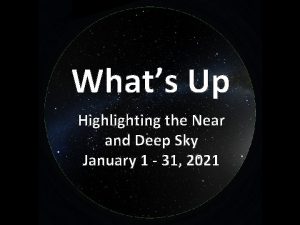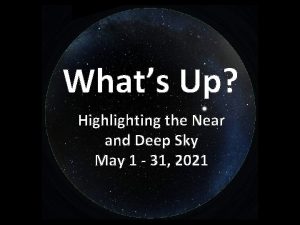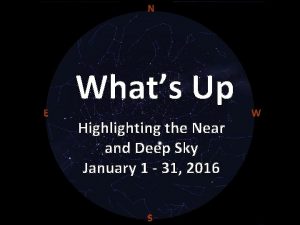N Whats Up E Highlighting the Near and










- Slides: 10

N What’s Up E Highlighting the Near and Deep Sky January 1 - 31, 2020 S W

General Information January 2020 • Among January’s celestial happenings: • The first major annual meteor shower of 2020 peaks, a day after first quarter moon. • Earth arrives at the first of 2020’s two apsides (extremes of its elliptical orbit). • Sleepy Sol has his last chance to get up late! • Sunset Range: 5: 13 p. m. (January 1 st) to 5: 43 p. m. (January 31 st). • End of Astronomical Twilight: 6: 46 p. m. (January 1 st) to 7: 12 p. m. (January 31 st).

Moon Phases January 2020 (All times shown are EST. ) • Thurs. , 2 nd, 11: 46 p. m. – First Quarter ü Locally, rises 12: 12 p. m. , on the 2 nd, sets 12: 25 a. m. on the 3 rd) • Fri. , 10 th, 2: 22 p. m. – Full Moon ü Locally, rises 5: 21 p. m. on the 10 th, sets 8: 22 a. m. on the 11 th) ü Penumbral lunar eclipse – not visible for most of the Americas • Fri. , 17 th, 7: 59 a. m. – Last Quarter ü Locally, rises 12: 18 a. m. on the 17 th, sets 12: 08 p. m. on the 17 th) ü Friday/Saturday moon-free observing January 17 th and 18 th • Fri. , 24 th, 4: 43 p. m. – New Moon ü Locally, rises 7: 28 a. m. on the 24 th, sets 5: 26 p. m. on the 24 th) ü Friday/Saturday moon-free observing January 24 th and 25 th

Celestial Events January 2020 Mon. , Jan. 27 th, 6: 30 p. m. • Wed. , 1 st – Moon at apogee; 63. 43 Earth-radii from Earth. • Fri. /Sat. , 3 rd/4 th – Quadrantid Meteor shower peaks (ZHR 110); best after 2: 00 a. m. on the 4 th (near first quarter moon sets at 1: 21 a. m. ). • Sun. , 5 th – Earth at perihelion; 0. 9832 AU from the Sun (147, 091, 144 km or 91, 398, 199 mi, center to center; 3% closer than at aphelion in July). • Sun. , 6 th – Latest sunrise of 2020 (7: 34: 04 a. m. for Roanoke). • Thurs. , 9 th – Moon at ascending node (ecliptic longitude 98. 4°). • Mon. , 13 th – Moon at perigee; 57. 38 Earth-radii from Earth (9. 5% closer than on the 1 st). • Wed. , 22 nd – Moon at descending node (ecliptic longitude 278. 4°). • Mon. , 27 th, 6: 30 p. m. – Challenge Observation: Spot 3 -day-old thin crescent moon low in the SW, and Venus above it, with Neptune 11 arcmin to SW.

Before we get to the night sky for January. . .

Tonight we’re celebrating the Winter Solstice, which occurs at 11: 16 p. m. this Saturday, December 21 st, marking the beginning of Winter. We talk about the “Winter Skies”, but Winter is 3 months long, and the star patterns and celestial objects most readily visible change over time. So, what do we mean by the “Winter Skies”?

Suppose by a season’s “skies” we meant the constellations and celestial objects that were in our most central viewing area at the end of astronomical twilight (about 90 minutes after sunset) at the middle of the season. So, what constellations or celestial objects do you think of as the hallmarks of the “Winter Skies”?

Tues. , Feb. 4, 2020, 7: 16 p. m. (end of twilight)

N January 15 th, th 9: 00 p. m. January 16 full , 6: 58 p. m. (~31 min. before darkness) (full darkness) For tonight, Mar. 19 th, 6: 37 p. m. Tonight, Dec. is 16 8: 31 p. m. about 31 min. is full darkness. before full darkness. E W Uranus Neptune S Venus

Questions ? ? ?











